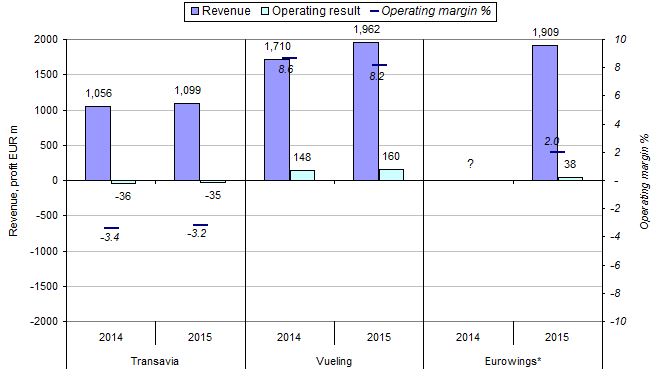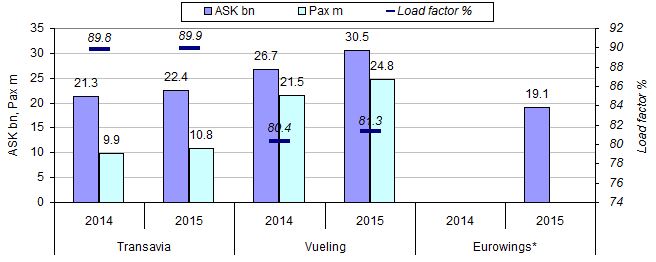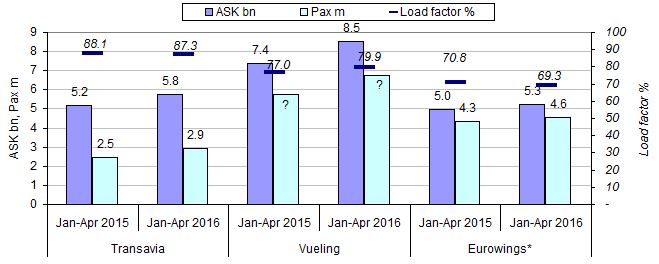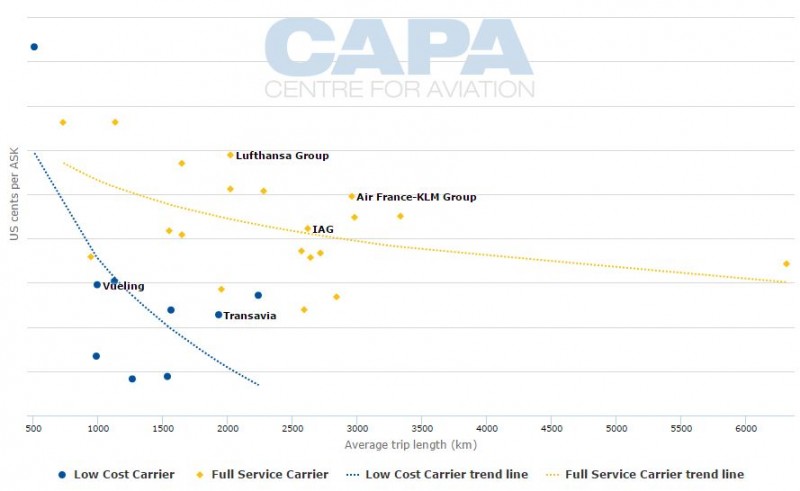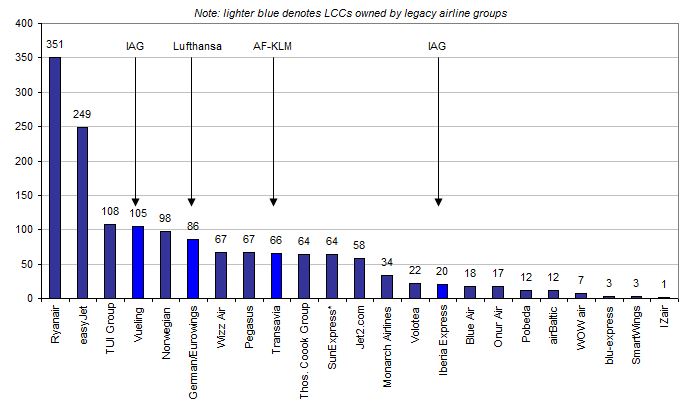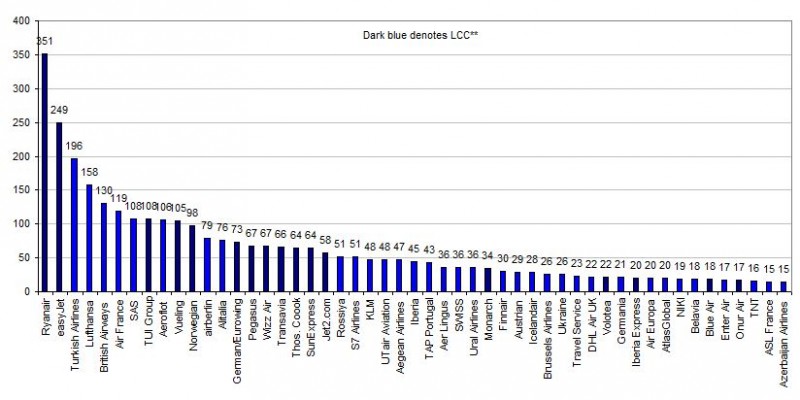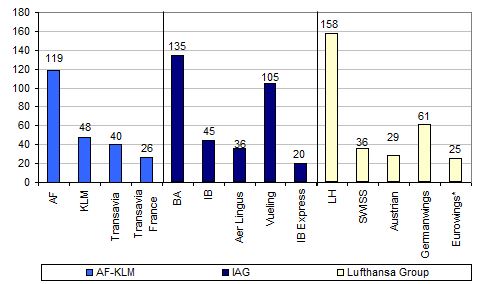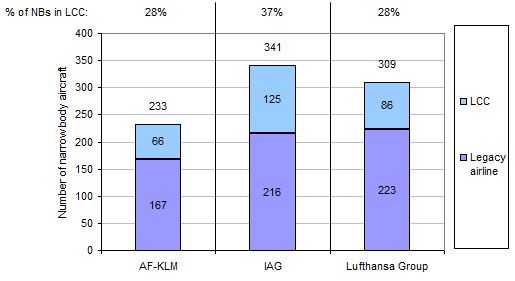Air France-KLM, IAG, Lufthansa LCC strategies: denial, submission, retreat, now counter-attack
Over 20 years the responses of Europe's big three legacy groups to the short/medium haul LCC revolution have all been through phases of denial, submission, retreat, and counter-attack.
Now all three now have a more clearly defined LCC strategy than in the past. IAG, with Vueling and Iberia Express, has the largest, most pan-European and most profitable LCC, helping the group to grow its short/medium haul traffic. The Lufthansa and Air France-KLM LCCs are more defensive, to preserve market share. Both have only recently started LCC bases outside their original home markets. Lufthansa (after a false start with high cost Germanwings, now transferring to Eurowings) has replaced mainline capacity with LCC capacity, route-for-route. Air France-KLM has grown Transavia while cutting mainline capacity, but without substitutions route-for-route.
Only Lufthansa has taken its LCC onto long haul routes, albeit on a limited scale. Facing the more complex challenges on long haul, all three are developing a growing range of partnerships with other airlines. They have also sought to improve labour productivity in their legacy network airlines, with varying degrees of success, but again led by IAG. A next step may even be to connect with their arch rivals.
- Europe's big three legacy groups have all developed a more clearly defined low-cost carrier (LCC) strategy.
- IAG's Vueling is the largest, most pan-European and most profitable LCC, helping the group to grow its short/medium haul traffic.
- Lufthansa and Air France-KLM's LCCs are more defensive, aiming to preserve market share.
- Only Lufthansa has taken its LCC onto long haul routes, albeit on a limited scale.
- Financial reporting and profitability records of the LCC subsidiaries have been inconsistent.
- Vueling is the biggest LCC by revenue and the most profitable among the three.
In this report, unless otherwise stated, "Eurowings" refers to the combined operation of Germanwings and Eurowings, which are managed by Lufthansa as a single business under the Eurowings brand. The transfer of capacity from Germanwings to Eurowings is due to be complete by 2017. In addition, "Transavia" is used to refer to the combined operation of the Dutch and French arms of Air France-KLM's LCC business.
For more background on the evolution of the LCC units of Air France-KLM, IAG and Lufthansa, see the report: Lufthansa, Air France-KLM, IAG adopt short haul initiatives to combat LCCs: Airlines in transition
Financial track record and reporting have been inconsistent for the three LCC subsidiaries
The financial reporting of Transavia, Vueling and Eurowings has been inconsistent, and their profitability records are quite different. Last year, 2015, was the first year since all three of the big legacy groups adopted their current LCC strategies that financial results (at least partial) were available for all three subsidiaries.
Transavia has not achieved a positive operating profit since its parent group started disclosing the LCC's annual results, beginning with the year 2011. Under Air France-KLM's Perform 2020 plan, Transavia aims to reach a profit in 2017.
Lufthansa reported results for its LCC Germanwings for a while, but stopped doing so after 2011 (it made an operating loss in both of 2010 and 2011).
See related report: Germanwings rebrands: you say you want a revolution? To be led by cost and operations
Lufthansa announced 2015 revenue and operating profit figures for its LCC in Mar-2016, under the new Eurowings brand, which combines the operations of both Germanwings and Eurowings in the transition phase. From 2016 Lufthansa is also reporting monthly traffic data for its Eurowings activities.
Among the three LCC subsidiaries of the big three legacy groups, only IAG's Vueling has consistently reported both quarterly and annual financial results. It has achieved a positive operating profit every year since 2009, well before IAG acquired it in 2013.
See related report: Vueling's new CEO only needs to stay ahead of rival LCCs on service quality. And keep cutting costs
Vueling is the biggest LCC by revenue and the most profitable among the three
Based on 2015 data Vueling is the biggest of the three by revenue, although it is only 3% bigger than Eurowings. Both are around 75% bigger than Transavia by revenue.
Vueling increased its revenue by 14% in 2015, while Transavia's revenue was up by only 4%. The revenue growth rate for Eurowings was not disclosed. Of the LCC subsidiaries of European legacy airline groups in 2015 Transavia was the least profitable, and Vueling the most profitable. Transavia's 2015 operating margin was -3.2%, compared with Vueling's 8.1% and Eurowings' 2.0%.
The leading independent LCCs were significantly more profitable than all three of these subsidiaries in 2015. Ryanair achieved an operating margin of 22.4% and Wizz Air made 16.5% in calendar 2015, while easyJet's margin was 14.7% for the year to Sep-2015.
The order of profitability among Transavia, Eurowings and Vueling has continued into 1Q2016. This seasonally weak quarter typically generates losses for most airlines in Europe and this was the case for all three this year. However, their margins of loss varied significantly.
Transavia made a 1Q operating loss of EUR63 million on EUR160 million of revenue, making a very wide 39% negative margin. This compares with Germanwings' operating loss of EUR86 million on revenue of EUR377 million, giving the Lufthansa-owned LCC a negative margin of 23%. IAG did not report revenue and operating results by individual airline in 1Q2016, but it did report a lease-adjusted operating margin of -6% for its LCC Vueling.
Transavia, Vueling, Eurowings*: revenue, operating profit (EUR million) and operating margin (%), 2014 and 2015
Eurowings' ASK growth was fastest among the three in 2015; Transavia had highest load factor
Although traffic data for Eurowings were not reported in 2015, it can be calculated from OAG schedules data that its ASKs increased by 25% (mainly due to growth on Germanwings-operated routes). Vueling's ASK growth was 14% and Transavia's 5% in 2015.
One of the few indicators on which Transavia leads the other two is its load factor, which was 89.9% in 2015, compared with Vueling's load factor of 81.3%. Eurowings' 2015 load factor was not disclosed, but the Lufthansa LCC has reported a figure of 69.3% for the first four months of 2016 and this suggests that its 2015 load factor was probably closer to 70% than to 80%.
Vueling carried 24.8 million passengers in 2015 - well over double Transavia's 10.8 million. Again, Eurowings' 2015 passenger numbers are not known, but based on OAG data on seat capacity and load factor assumption of around 70%, it may have carried in the region of 15 million passengers.
Transavia, Vueling, Eurowings*: traffic data 2014 and 2015
Eurowings' growth has slowed in 2016 so far; Transavia's has accelerated
In the first four months of 2016 Transavia's ASK growth rate picked up to reach 11% and its load factor dipped by 0.7ppts, to 87.3%. Vueling has grown faster, at 15% (similar to its growth last year), and increased its load factor by 2.9ppts to 79.9%.
Eurowings' short/medium haul ASK growth rate in the first four months of 2016 slowed to 6% (the Germanwings operation is shrinking, while Eurowings itself is growing) and its load factor fell by 1.5ppts to 69.3%.
Transavia, Vueling, Eurowings*: traffic data Jan-Apr 2015 and 2016
Air France-KLM and Lufthansa mainly use LCCs to preserve group market share; IAG pursues incremental traffic
For both Air France-KLM and the Lufthansa Group, the growth of the LCC has primarily been aimed at preserving overall market share in short/medium haul point-to-point markets, rather than generating significant new traffic for the group.
See related reports:
Unlike the other two groups' LCCs, IAG's Vueling has been a significant source of incremental traffic for IAG. Since its acquisition by IAG in 2013 Vueling has continued with the double-digit rates of growth that it had achieved previously.
Transavia's growth has mainly been driven by the addition of new routes for Transavia France. While not directly replacing routes previously operated by Air France (in no small part due to restrictions in pilot agreements with AF management), this activity has been accompanied by capacity cuts from the French flag carrier in short/medium haul point-to-point markets.
On some routes, Transavia flies alongside Air France. In the Netherlands, Transavia's growth has been slower, with the business transforming from a charter to a scheduled operator.
The Lufthansa group's approach has been different from that of Air France-KLM. From 2013 to 2015 its LCC growth was driven by the direct transfer from Lufthansa to Germanwings of point-to-point routes that did not touch its main hubs at Frankfurt and Munich. There was a corresponding reduction in Lufthansa main line capacity on these routes and so, there was little overall growth in the combined Lufthansa/Germanwings short/medium haul operation.
Unfortunately, Germanwings was never sufficiently low cost to be truly competitive against a growing level of competition from LCCs in Germany. Although no separate data was reported for Germanwings for the years 2012 to 2014, a CAPA analysis in 2013 estimated that both Vueling and easyJet had unit costs around 30% lower than those of Germanwings. Ryanair's unit cost was almost 60% lower.
See related report: Germanwings rebrands: you say you want a revolution? To be led by cost and operations
Since 2015 Lufthansa has initiated a new transition of short/medium haul point-to-point routes - this time, from Germanwings to the lower cost Eurowings, which has a more flexible pilot contract. The strategic shift of capacity from mainline to LCC was broadly completed in 2015. The focus now is on the transfer from one LCC platform to another, as can be seen from the slower ASK growth rate of the combined Germanwings/Eurowings operation in the first four months of 2016.
CASK analysis shows Vueling and Transavia as true LCCs…
Both Vueling and Transavia have a level of unit cost (cost per available seat kilometre, CASK) that is consistent with that of other European LCCs having the same average trip length. Furthermore, as with competitor LCCs, Vueling's and Transavia's CASK levels are much lower than those of their parent groups.
Among the three groups, IAG's CASK is the lowest, but there are several other European legacy airlines with lower unit costs and IAG sits more or less on the FSC trend line (see chart below).
Europe airlines: cost per available seat kilometre (CASK, USc) versus average passenger trip length (km), 2014*
However, Germanwings is a high cost platform, and this explains the transfer to Eurowings
It has not been possible to calculate an accurate CASK figure for Eurowings, but 2015 revenue and operating profit data reported by Lufthansa allow its costs to be calculated. Combining this with ASK figures for 2015 from OAG schedules data leads to an estimated CASK for Eurowings (including Germanwings) in 2015.
This approach indicates that the Eurowings business has a CASK that may be at least two thirds higher than Vueling's, which is close to easyJet's CASK. Eurowings' CASK is considerably more than twice that of the ultra-LCC Ryanair. This much higher unit cost is only partly explained by its shorter average trip length (only 15% less than Vueling's, for example). It suggests that the term LCC really does not apply, at least not to Eurowings' old incarnation.
In 2015 the vast majority of the business now called Eurowings was still operated by Germanwings. These CASK estimates highlight Germanwings lack of cost efficiency and explain why Lufthansa no longer wants to use it as its LCC operator. This has become even more acute since Ryanair stepped up its presence in Germany.
See related report: Ryanair, with costs 60% below Lufthansa's, begins an onslaught on domestic Germany
The Germanwings platform still accounts for the majority of the production managed under the Eurowings brand. As the transfer to Eurowings production continues through 2016 and into 2017, the level of CASK for the brand should reduce significantly.
SunExpress Germany could give Lufthansa a further option in Europe
Lufthansa may also be keeping another option for low cost platforms up its sleeve in the form of SunExpress Germany. Through a somewhat complicated holding structure, this leisure oriented airline is majority controlled by Lufthansa, and Turkish Airlines is a part-owner. SunExpress Germany is now providing Eurowings with wet-lease capacity for its long haul low cost routes (see below).
In short/medium haul, SunExpress Germany originally focused on routes between Germany and Turkey, but it now appears to be reducing its emphasis on this core market and growing in markets from Germany to other European destinations. It seems that SunExpress Germany may be embarking on a shift towards a more pan-European network.
Indeed, although SunExpress Germany is still relatively small, its network is starting to take on some of the appearance of Eurowings on short/medium haul. It is not classified as an LCC in CAPA's database, but has a cost-efficient operation and many LCC-like characteristics. This may give Lufthansa an alternative, or additional, low cost operator in Europe if it chooses to use it in this way in Europe in addition to long haul markets.
See related report: SunExpress Germany: summer 2016 route launches may signal a shift to a more pan-European model
In Vueling and Iberia Express IAG has largest LCC narrowbody fleet among the three groups
Looking at the LCC fleets of the three groups at 17-May-2016, Vueling's 105 Airbus A320 family aircraft gives it the fourth largest narrowbody LCC fleet in Europe - behind Ryanair, easyJet and the airlines of the TUI Group (data source: CAPA Fleet Database).
IAG also owns Iberia Express, which was established with a much lower unit cost than the mainline Iberia operation. Its mission involves feeding Iberia's Madrid hub and its business model includes premium passengers. Iberia Express is a much more integrated part of the mainline business than the more stand-alone Vueling and its traffic and financial results are included with those of Iberia, with no separate disclosure.
These characteristics place Iberia Express as a hybrid between LCCs and network airlines, but it is now included in CAPA's LCC database. Together with the Vueling fleet, its fleet of 20 Airbus aircraft gives IAG a total of 125 LCC narrowbodies.
The Eurowings/Germanwings combined fleet of narrowbodies is 73 Airbus aircraft, but Eurowings is still operating 13 Bombardier CRJ900s that are due to be replaced by A320s. Counting these regional jets in the total, Eurowings' short/medium haul fleet consists of 86 aircraft, the sixth largest among European LCCs. Transavia's 66 Boeing 737s give it the ninth ranked European LCC narrowbody fleet.
Vueling, Transavia and Eurowings/Germanwings are all among the group of 10 second tier European LCCs, all with roughly 60-100 narrowbodies. Among these airlines are counted three that are not fully classified as LCCs in CAPA's database.
Two of the three - the airlines of the TUI Group and of the Thomas Cook Group - are combinations of several airlines with a common owner but with varying degrees of autonomy, and some are categorised as LCCs while others are not. They all have some LCC-like characteristics (point-to-point, leisure focus, low fares). SunExpress (including its subsidiary SunExpress Germany) is also included, since it appears to have a cost structure that is similar to that of LCCs in Europe and its use by shareholders Lufthansa and Turkish Airlines suggests that they view it as a low cost platform.
See related report: Europe LCC consolidation: 2nd-tier LCCs, legacy groups more likely to combine than Ryanair, easyJet
Europe: LCCs** ranked by number of narrowbody aircraft as at 17-May-2016
Not only do Ryanair and easyJet have the biggest LCC fleets in Europe, but they also have more narrowbody jets than any other European airline.
The largest European FSC narrowbody fleets - Turkish Airlines, Lufthansa, IAG's British Airways, Air France, Aeroflot and SAS - are all smaller than those of the two leading LCCs, although they are larger than those of Vueling, Eurowings and Transavia.
Europe: top 50 airlines ranked by number of narrowbody aircraft as at 17-May-2016
The three LCCs are increasingly important to their groups' overall narrowbody operations
As they grow, the narrowbody fleets of the three LCC subsidiaries are increasingly significant to their parent groups. Within Air France-KLM, the total Transavia fleet of 66 aircraft is bigger than KLM's narrowbody fleet of 48.
Vueling is IAG's second largest narrowbody operator; its 105 aircraft are more than the combined narrowbody fleets of Iberia and Aer Lingus, and not very much below British Airways' fleet of 135 narrowbodies.
The 'new' Eurowings total short/medium haul fleet of 86 aircraft is more than the combined narrowbody fleet of SWISS and Austrian and well over half of Lufthansa's 158 narrowbodies.
Air France-KLM, IAG and Lufthansa Group* narrowbody fleet numbers by subsidiary airline 17-May-2016
37% of IAG narrowbodies are LCC; 28% for both the Lufthansa Group and Air France-KLM
IAG's LCC fleet of 125 aircraft (Vueling plus Iberia Express) accounts for 37% of the group's narrowbody fleet of 341 aircraft. The Lufthansa Group's LCC fleet of 86 represents 28% of its narrowbody fleet of 309 aircraft (including 13 Eurowings CRJ900s). The Air France-KLM LCC fleet of 66 aircraft is 28% of the group's 233 narrowbodies.
Air France-KLM, IAG* and Lufthansa Group** narrowbody fleet numbers split between LCC and legacy airlines, 17-May-2016
Vueling's network is larger and wider than the other two; Transavia the smallest
On all of the broad measures of size (revenue, operating profit, ASKs, passenger numbers, fleet size), IAG's LCC operations are the biggest and Air France-KLM's are the smallest among Europe's big three legacy airline groups.
Through Vueling IAG also has the widest short/medium haul LCC network of the three. Vueling operates to 32 countries, compared with Eurowings' 27 and Transavia's 24, and the airline bases aircraft in several countries across Europe. By contrast, Eurowings has only recently established its first non-German base in Vienna and Transavia has recently opened its first non-Dutch, non-French base in Munich.
Vueling's network comprises 122 airports and 304 routes, compared with Eurowings' 108 airports and 265 routes (short/medium haul only) and Transavia's 99 airports and 202 routes. Note that the Vueling figures do not include Iberia Express, which would further extend IAG's lead.
It is no coincidence that the most successful LCCs in Europe tend to be those with a broad base of operations across a number of countries. The size that comes from having a pan-European network allows purchasing efficiencies with suppliers and buying power with airports. In addition, a multi-base, multi-country strategy leads to brands that enjoy recognition by passengers at both ends of the routes, and allows access to local pools of labour on a more cost-efficient basis.
Transavia, Vueling, Eurowings*: short/medium haul network comparison, week of 16-May-2016
|
|
|||
|---|---|---|---|
|
Airports |
99 |
122 |
108 |
|
Countries |
24 |
32 |
27 |
|
Routes** |
202 |
304 |
265 |
|
Ave. routes per airport |
2.0 |
2.5 |
2.5 |
|
Ave. weekly one way freq per route |
4.8 |
6.3 |
6.6 |
|
Ave trip length km (calendar 2015) |
1,867 |
999 |
847 |
Transavia lags behind Vueling and Eurowings on network density and frequencies
In addition to the size and breadth of the three networks, there are other network differences that shape the customer bases. Both Vueling and Eurowings have an average of 2.5 routes per airport, a measure of network density indicating the range of destinations available from each airport. Both are ahead of Transavia's 2.0, but all three are significantly behind Ryanair's average of 6.7 and easyJet's 5.0.
Transavia also lags Vueling and Eurowings on frequencies, with an average weekly one-way frequency of 4.8 times on each route, compared with 6.3 for Vueling and 6.6 for Eurowings (short/medium haul only). Higher frequencies tend to give a network greater appeal to business passengers and other higher-yielding traffic.
Transavia's lower frequencies are more consistent with a more leisure-oriented network. This is also evident in its longer average trip length of 1,867km in 2015, which reflects a greater focus particularly on the sun routes in countries around the Mediterranean. This compares with 999km for Vueling and 847km for Eurowings.
Transavia, Vueling and Eurowings*: countries served, week of 16-May-2016
|
|
|||
|---|---|---|---|
|
1. |
|||
|
2. |
|||
|
3. |
|||
|
4. |
|||
|
5. |
|||
|
6. |
|||
|
7. |
|||
|
8. |
|||
|
9. |
|||
|
10. |
|||
|
11. |
|||
|
12. |
|||
|
13. |
|||
|
14. |
|||
|
15. |
|||
|
16. |
|||
|
17. |
|||
|
18. |
|||
|
19. |
|||
|
20. |
|||
|
21. |
|||
|
22. |
|||
|
23. |
|||
|
24. |
|||
|
25. |
|
||
|
26. |
|
||
|
27. |
|
||
|
28. |
|
|
|
|
29. |
|
|
|
|
30. |
|
|
|
|
31. |
|
|
|
|
32. |
|
|
Lufthansa's Eurowings is the only one of the three LCCs with long haul operations
One further important difference between the three groups in their approach to low cost operations is in the area of long haul routes. Of the three LCC subsidiaries, only Eurowings has a long haul operation.
Launched in Nov-2015, Eurowings' long haul network now includes seven routes from Cologne/Bonn: three in Latin America (Punta Cana, Cancún and Varadero), two in Asia Pacific (Bangkok and Phuket) and one in Africa (Mauritius). Its focus is point-to-point leisure routes and it currently has no plans to operate from either of Lufthansa's main hubs at Frankfurt or Munich.
Eurowings' long haul routes are operated on its behalf under wet-lease arrangements by SunExpress Germany, currently deploying three A330-200 aircraft. Eurowings also has approvals to fly to the US, planning to launch Miami, Boston and Las Vegas services in summer 2016.
See related report: Lufthansa's Eurowings goes to America; will the pilots unions allow US DoT to issue an exemption?
Eurowings long haul: impressive load factor, but small scale
Data reported by Lufthansa for the first four months of this year show that Eurowings' long haul routes carried 189,000 passengers between Jan-2016 and Apr-2016.
These routes have achieved an impressive load factor of 94.0%, demonstrating healthy demand, although the extent to which this performance has been stimulated by price discounting is not yet known. These figures also show that, for now, Lufthansa's low cost long haul activities remain small.
See related report: Lufthansa to Germanwings to Eurowings. Long haul and lower cost as Lufthansa seeks solutions
Lufthansa long haul strategy: the LCC and developing partnerships, but not with Gulf airlines
Lufthansa's long haul strategy is the only one among Europe's big three to include a low cost brand. However, although it is growing, Eurowings is likely to remain a smaller proportion of the group's long haul business than it is on short/medium haul. Eurowings currently has three widebodies and plans to have seven in 2017, which compares with 149 wide bodies in the Lufthansa Group at 19-May-2016 (source: CAPA Fleet Database).
Moreover, Eurowings long haul network is mainly concentrating on leisure routes and secondary cities. It is not a replacement for Lufthansa's mainline long haul brands. However, if it is successful, it will give Lufthansa management additional leverage in negotiating labour productivity improvements in its high cost mainline operations. Better labour cost efficiency is an important element of its long haul strategy.
The Lufthansa Group's long haul strategy also includes other important strands. As with the Air France-KLM and IAG groups, Lufthansa's long haul business is also increasingly reliant on partnerships with other airlines. All three have significant immunised JVs with North American partners on the North Atlantic, which have been very profitable.
Lufthansa has led European airlines in the development of the JV concept in other regions, particularly in Asia Pacific, where its market position faces the greatest competitive threat from Gulf airlines. On routes between Japan and Europe it has a JV with ANA (this also includes Austrian and SWISS), and has long been planning a JV with Air China.
See related report: Lufthansa: a joint venture with Air China could mean almost half its ASKs are covered by JVs
In addition, in 2015 Lufthansa and Singapore Airlines signed an agreement to operate limited routes between Singapore and Europe on a JV basis (the agreement also includes Austrian, SWISS and SilkAir).
See related reports:
- Lufthansa, Singapore Airlines respond to Gulf competition with a limited JV. There is scope for more
For the Lufthansa Group, intercontinental routes account for a lower proportion of total seats than for the other two groups (17% for the Lufthansa Group, 22% for IAG and 29% for Air France-KLM, according to data from OAG for Jul-2016).
This partly reflects the fact that it has a larger European network, but it also has fewer intercontinental seats in absolute terms (i.e. not only as a percentage of the total). Its main hub at Frankfurt is a smaller O&D market than London and Paris, and this means that its long haul network is also more dependent on sixth freedom transfer traffic.
The Lufthansa Group's greater long haul vulnerability helps to explain its vocal opposition to Gulf airline competition, compounded by its lack of any form of partnership with a leading Gulf carrier.
IAG long haul strategy: Aer Lingus 'low cost long haul'; Qatar Airways partnership; China JV sought
Willie Walsh, the IAG CEO, has referred to Aer Lingus as IAG's 'low cost long haul' platform. From analysis of Aer Lingus financial and traffic data prior to its acquisition by IAG it can be deduced that it is certainly a cost-efficient long haul operation by comparison with Europe's larger legacy airlines - including BA, Lufthansa and Air France - but not low cost in an absolute sense.
Nevertheless, this reinforces IAG's advantage over Lufthansa and Air France-KLM in having lower unit costs. This is partly based on IAG's earlier success with implementing improved labour productivity. This began with British Airways before the formation of IAG and continued with Iberia, where change was aided by the creation of Iberia Express and Vueling. Although these two airlines are not long haul operators, they helped IAG to effect cultural change across Iberia's business.
Even if Aer Lingus is relatively cost-efficient, its long haul network only operates on the North Atlantic, where it undoubtedly adds to IAG. This will be even more apparent when Aer Lingus joins the immunised North Atlantic JV within oneworld that involves BA, Iberia, American airlines and Finnair.
However, Aer Lingus is small and has no network to Asia, where IAG is dependent on British Airways. After the end of its Qantas JV BA has relied more on its own capacity, particularly as its relationship with its oneworld partner Cathay Pacific has been strained. A mainland Chinese partner appears to be an important requirement for BA.
See related report: Cathay Pacific diversifies in Europe, British Airways seeks China JV, as their partnership devolves
IAG is now also developing its in-house options in Asia, with Iberia returning to the market after many years through planned new services to Tokyo and Shanghai.
See related report: Iberia to launch Tokyo & Shanghai in Asia return after many years. Another sign of approval from IAG
By contrast with Lufthansa's intransigence on Gulf airline cooperation, IAG has a growing commercial relationship with oneworld partner Qatar Airways, which reportedly increased its equity stake in IAG to 15% in May-2016. Qatar Airways bought 10% of IAG in early 2015, increasing this to 12% in Apr-2016, before taking it up to its current level.
See related reports:
- Qatar Airways buys its 10% stake in IAG, showing it wants a serious relationship
- British Airways India routes: aircraft gauges changed & partners considered as third party hubs loom
The commercial partnership mainly consists of codeshares, but this - and the equity stake - provide a platform on which IAG and Qatar Airways could build a deeper cooperation, with some form of JV on the agenda. This will also increase IAG's options in Asia.
Air France-KLM long haul strategy: no low cost; AF capacity cuts; possible SIA partnership
Air France-KLM currently has no long haul low cost operation. On a conference call in May-2016 to discuss its 1Q2016 results the group's management told analysts that long haul low cost was not something to disregard, but it was sceptical about the sustainability of year-round profits.
With regard to Gulf airlines, Air France-KLM has been more embracing of them than has Lufthansa, but only just. It is much less open to them than IAG. Air France-KLM has limited codeshares with Etihad, but has joined Lufthansa in criticising them with anti-Gulf rhetoric. It has also sought to rely on the French state's parsimonious attitude towards the granting of traffic rights to Gulf airlines.
Air France-KLM's long haul network is profitable, in contrast with short/medium haul losses. As with the other three, its North Atlantic JV (with Delta) is an important and profitable part of this network.
Nevertheless, the group as a whole suffers from poor labour productivity, particularly in Air France. Management is imposing long haul capacity cuts at the French flag carrier and will only restore growth if pilots agree to its proposed productivity improvements.
See related report: Air France-KLM makes progress in 2015, but still has more to do. Labour productivity is at the heart
The group's perennially poor margins increase the pressure on Air France-KLM to come up with new strategic options. It is reportedly in talks with Singapore Airlines about forming a JV on routes between France and Singapore.
See related report: Air France-Singapore Airlines partnership talks highlight lack of Gulf airline penetration in France
IAG has the most successful LCC strategy among Europe's big three, also helping to change core business
Among Europe's big three legacy airlines, IAG's LCC strategy has been the most successful. Focused on short/medium haul, its main LCC operation is Vueling, which is bigger and more profitable than Lufthansa's Germanwings and Air France-KLM's Transavia.
Vueling had the advantage of being a successful pan-European LCC on a stand-alone basis before IAG acquired it. Moreover, the creation of Iberia Express helped IAG to improve labour productivity across Iberia by demonstrating that it had an alternative platform.
The more home-grown Eurowings at Lufthansa and Transavia at Air France-KLM have struggled with profitability. They have also had less freedom than Vueling to pursue growth opportunities across Europe, because they are more focused on replacing capacity cuts by their mainline sister airlines - directly in the case of Eurowings and indirectly in the case of Transavia.
Transavia's growth remains constrained by the Air France pilot agreement and it looks set to continue to be the smallest LCC subsidiary of the big three legacy groups in Europe. Through its Dutch arm, it is adding bases outside its two home markets, but it is a long way behind the leading European LCCs in this respect.
Only after two years of growing its LCC operation through Germanwings, whose pilots are covered by the same agreement as Lufthansa mainline, did Lufthansa make the switch to the more cost-efficient Eurowings. This has cost it time in growing beyond its home country, although the Vienna base marks a first step towards a more pan-European approach (and SunExpress Germany may add to Lufthansa's options).
The relative success of these three LCCs is important, not only intrinsically but also in the way in which they provide their owners with alternative growth platforms, thereby increasing their bargaining power to push through labour productivity improvements in their mainline operations.
Lufthansa is the only one to attempt the low cost model on long haul, but its small scale and the lack of similar developments at IAG and Air France-KLM highlight that long haul low cost is still in its infancy in Europe.
The low cost long haul model may have a role to play for Europe's legacy airlines. However, IAG has shown that internally generated cost efficiency enhancements in the core business, based on labour productivity, are probably a better starting point in meeting the challenges of competing on long haul.
Then again, if you can't beat them, use them...
One approach, often fuelled by Ryanair's Michael O'Leary, is to cede many of the uneconomic feeder routes to the local LCCs. With their lower cost base and diminishing yield differentials, they are able to offer very attractive options for servicing the big three's long haul routes.
For obvious reasons, not the least brand differentiation and avoidance of commoditisation, they have been most reluctant to do it in the past. Now IAG CEO Willie Walsh, the most entrepreneurial of the European full service airline CEOs, has declared it increasingly "inevitable" that this sort of connectivity should occur. Under his overall guidance, Aer Lingus and Ryanair are negotiating for Ryanair to feed passengers from its European network to Aer Lingus' long haul flights.
This could well be the shape of things to come.
